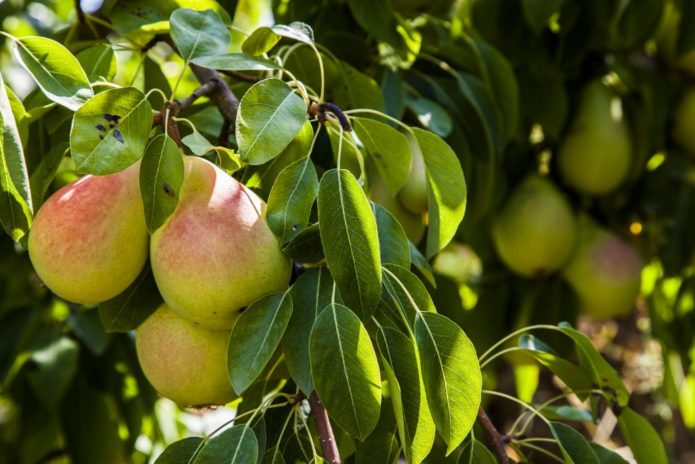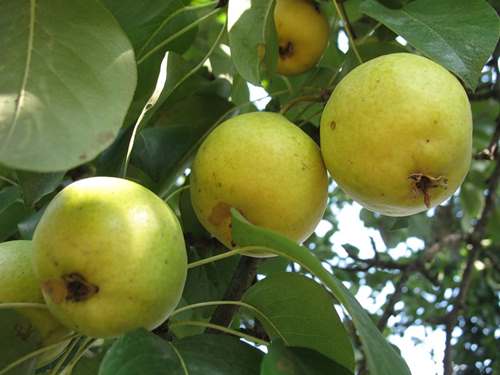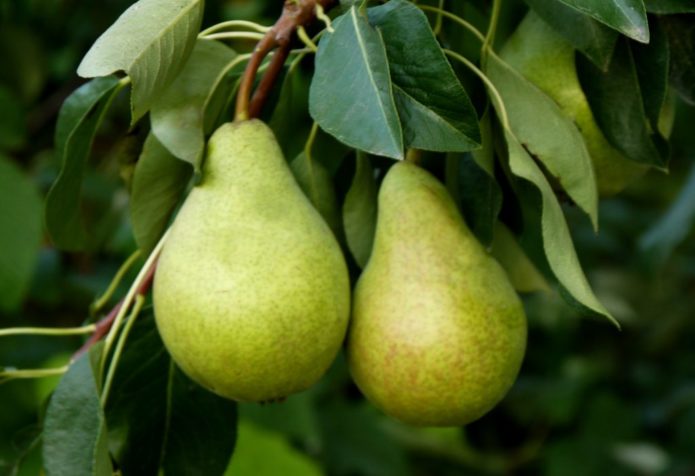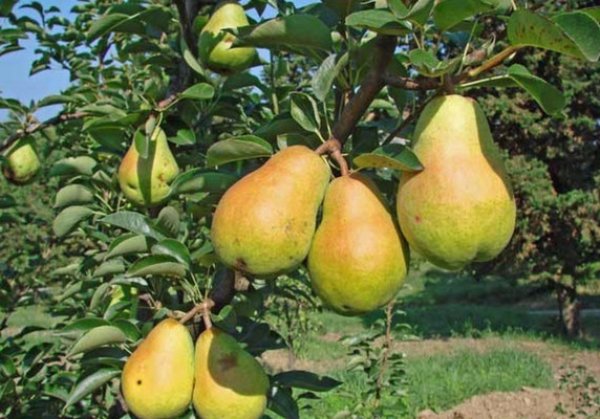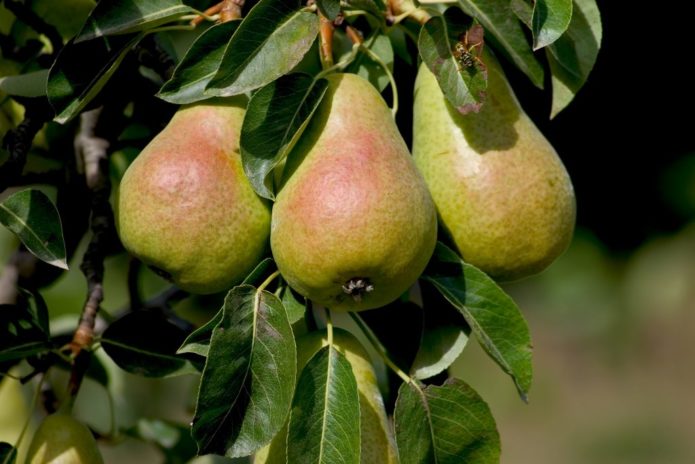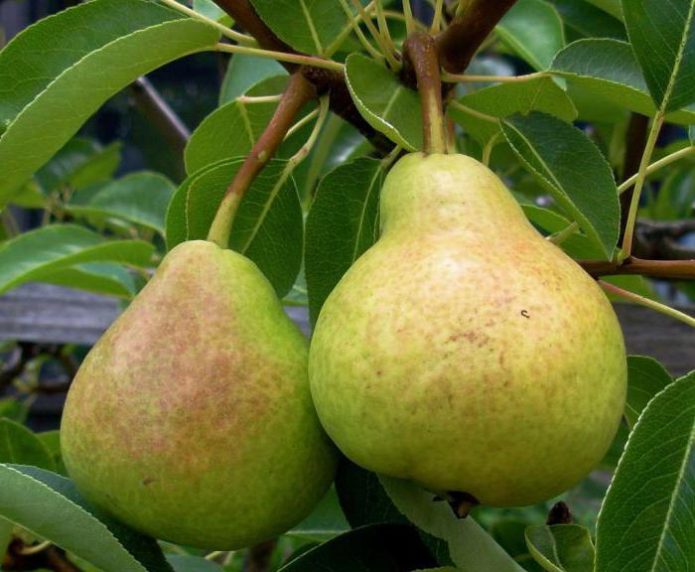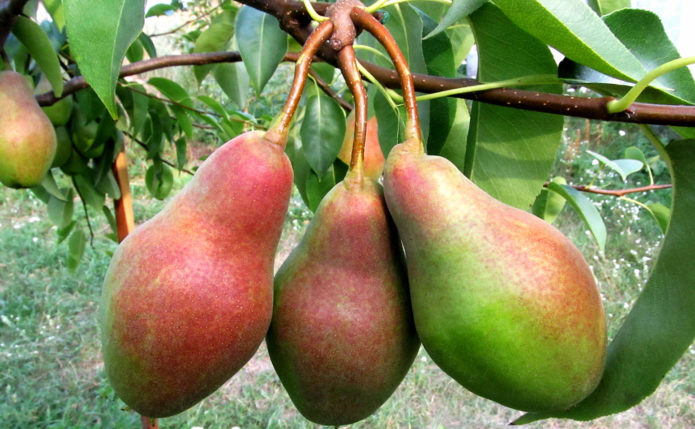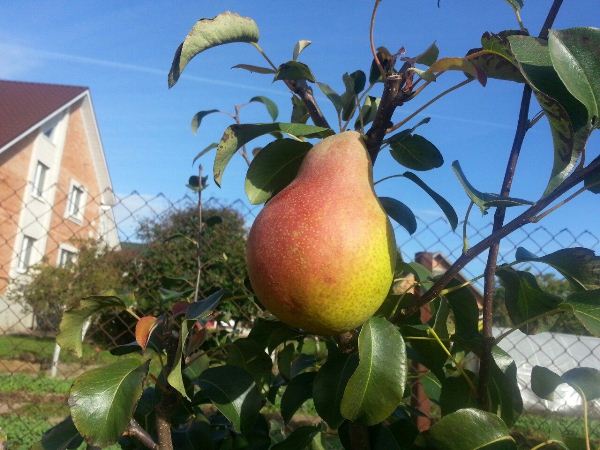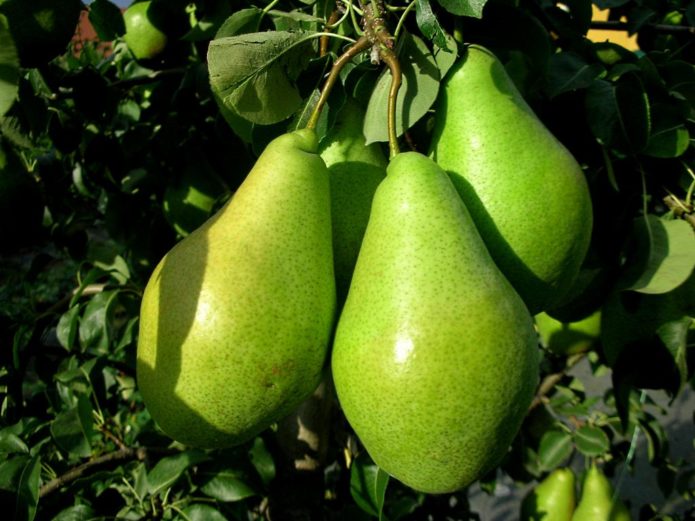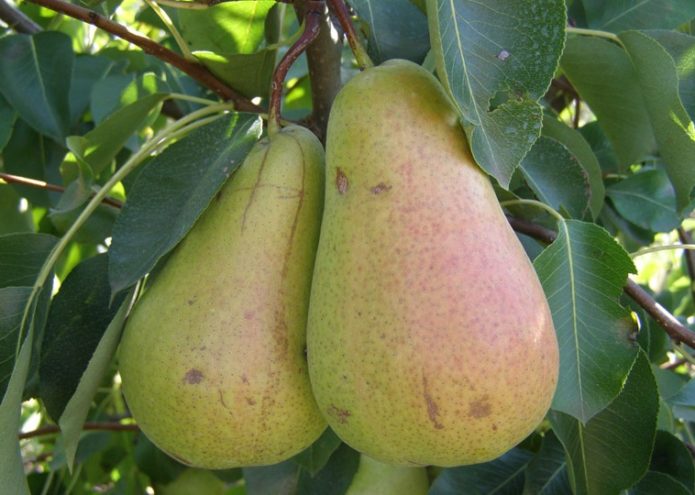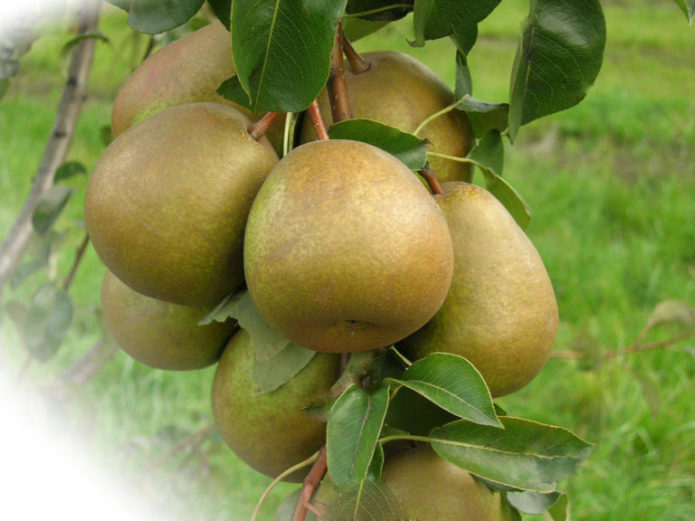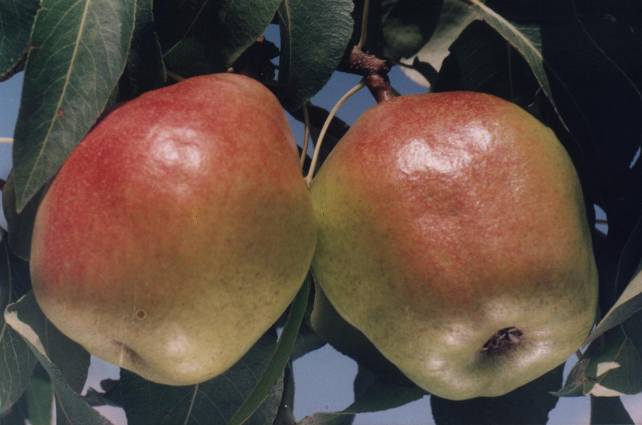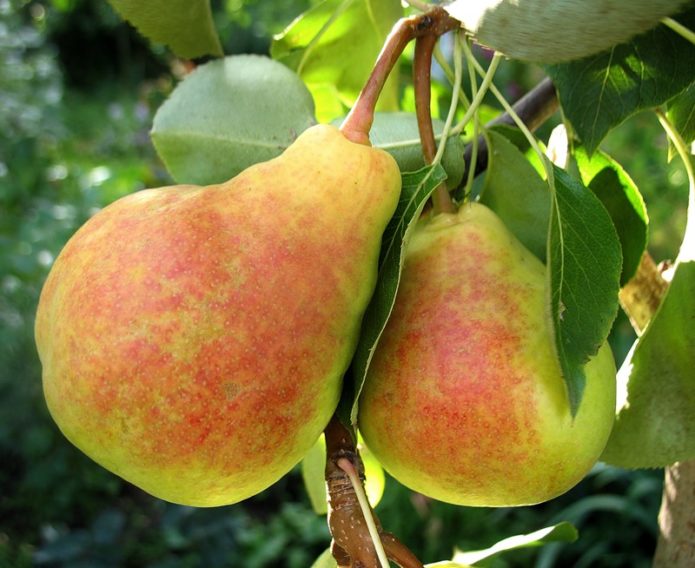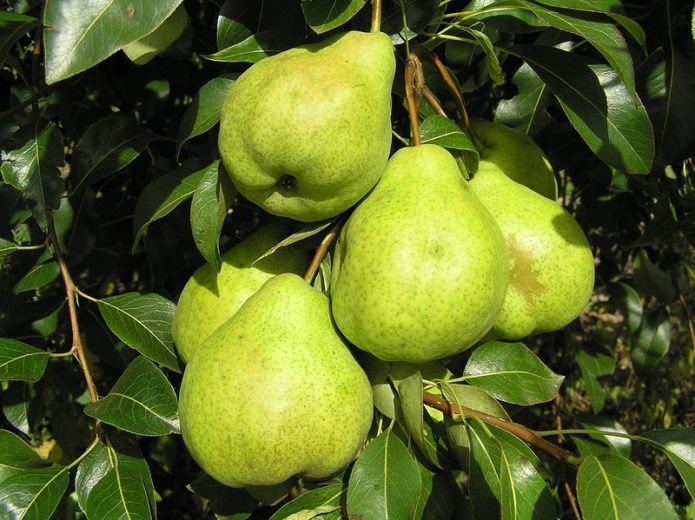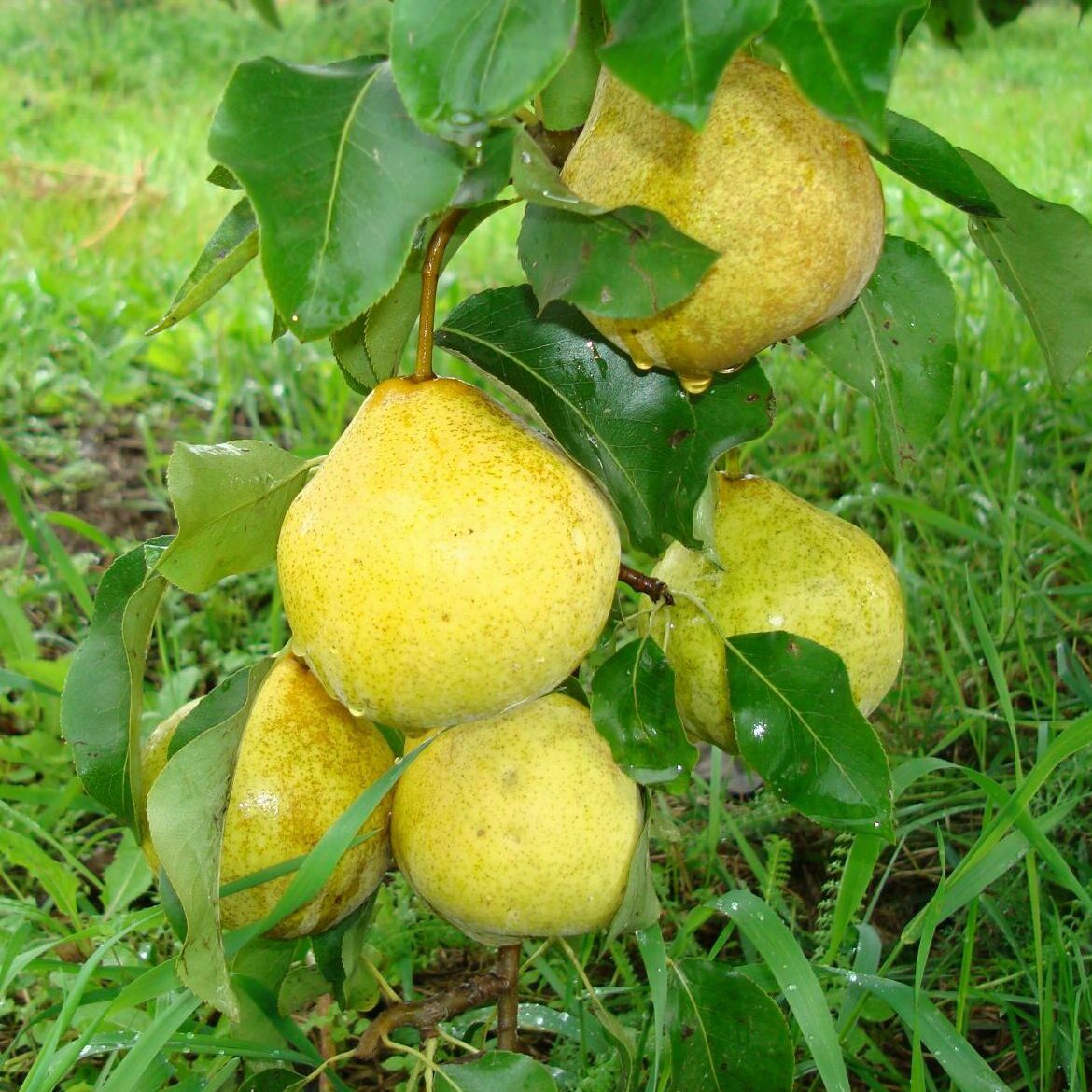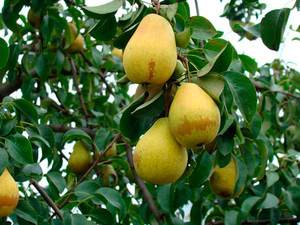Until recently, pear cultivation in Russia was available only to gardeners living in warm southern regions. But thanks to the work of breeders, new varieties with improved characteristics constantly appear - more frost-resistant, unpretentious in care, large-fruited. At the same time, in terms of taste, such fruits successfully compete with southern ones. There are varieties of different ripening periods, so pears can be eaten from mid-summer to winter. There are enough of them to make an reasoned choice, you need to familiarize yourself with the advantages and disadvantages of each of them.
Content
The best self-fertile pear varieties
Breeding work on the development of new pears has been going on for a long time. Now gardeners grow both completely new varieties and old time-tested varieties that have been known for more than one century.
The vast majority of pear varieties are self-fertile. This means that pollen from another nearby pear tree is needed to form fruit ovaries. But there are also exceptions. Self-fertile varieties are especially in demand by gardeners living in areas with unfavorable climatic conditions - insects, as a rule, are not particularly active in cool rainy weather. It is also a good option for owners of standard "six acres".
Chizhovskaya
The variety is recommended by the State Register for cultivation in the European part of Russia. Belongs to the category of late summer, ripens in August-September. It is valued for its frost resistance, immunity to scab, regularity of fruiting, early maturity.
The tree is 1.8–2.5 m high. The crown of young specimens is oval, not particularly thickened. With age, it turns into something that looks like a pyramid or a cone.
Fruits are elongated, weighing 100–120 g; as the tree grows, they become smaller to 80–90 g. The skin is smooth, matte, rather thin, dry to the touch. Ripe pears are greenish-yellow in color with brighter subcutaneous dots. The blush is completely absent or very weak. The pulp is pale yellow, tender, oily, with a mild aroma. The taste is sweet with sourness, estimated at 4.1-4.2 points out of five. Average yield is about 50 kg. Shelf life is 2–4 months. Ripe pears stay on the branches for a long time, and even if they fall to the ground, they do not deteriorate for a week.
Video: characteristics of the Chizhovskaya pear variety
Tenderness
The variety was originally bred for cultivation in central Russia, but then it showed itself well in regions with a more severe climate. The tree is vigorous, the crown is sparse, in the form of a wide oval. It reaches a height of 4–5 m. The pear brings its first harvest in the 4–5th year after planting in the ground. On average, you can count on 45-60 kg per tree.
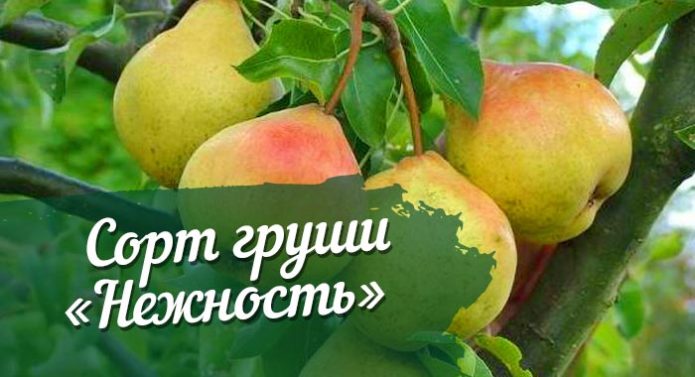
Pear Tenderness was bred for cultivation in central Russia, but has successfully taken root in regions with a more severe climate.
The average weight of rounded pears is 150-200 g. The color of the skin changes from bright green to sunny yellow as it ripens. Where the sun hits the fruit, a pale pink blush appears. The skin is dense, rough, with greenish-brown subcutaneous punctures. The pulp is oily, creamy, homogeneous, very tender and aromatic. The taste is sweet, with a slight sourness and pronounced astringency.
Banquet
The variety belongs to late autumn. Fruits reach technical maturity in September, full - in October-November. Recommended for cultivation in the Volga region. It is appreciated for its early maturity (the first harvest in the 3-4th year after planting), regular fruiting, good frost and drought resistance. Diseases and pests are moderately affected.
The tree is not particularly vigorous, the crown is thickened, densely leafy, in the form of a wide pyramid. The fruits do not fall off for a long time, but they do not differ in very good transportability.
The pears are rather large (260 g), one-dimensional, symmetrical round shape. The skin is smooth and dry to the touch, hard (even rough), matte. The main color is yellow-green, characterized by the presence of a vague blush of different shades, from crimson-raspberry to dull red. The subcutaneous points are numerous, beige-gray.
The pulp is white or with a yellowish undertone, very tender, buttery. The taste is balanced, sweet and sour, estimated at 4.5 points. The variety belongs to the category of dessert. The harvest can be stored in the refrigerator until the New Year.
In memory of Yakovlev
The variety that manifests itself best in the Volga region, the Black Sea region and in general in central Russia. Undoubted advantages - very high winter hardiness, good and stable productivity, the presence of "innate" immunity to scab, early maturity, transportability. It is very much in demand by breeders.

Yakovlev's Memory Pear is practically devoid of shortcomings, therefore it is widely used by breeders when breeding new varieties
The height of the tree is no more than 2.5 m. The crown is compact, up to 2 m in diameter, strongly thickened. It differs in its growth rate, reaching its maximum size by the age of 6-7 years. The first pears ripen at the end of August; the harvest is harvested throughout September. Shelf life is 3-4 weeks maximum.
The fruits are flat, round-pear-shaped, weighing about 125 g. Sometimes there are weak ribs. The skin is smooth, glossy, pale yellow, with a pinkish-orange blush. The pulp is creamy, semi-oily, sweet, with a subtle sourness, absolutely no astringency, very juicy and aromatic. Sometimes it contains "stony" blotches. Average yield is about 25 kg.
Video: description of the pear variety in Memory of Yakovlev
Rogneda
The variety is recommended by the state register for cultivation in the Central region. Especially popular with gardeners in the Moscow region and the Kaluga region. Belongs to the category of late summer. But the winter hardiness is excellent - pears do not freeze even in Siberia.
The tree is of medium vigor, the crown is in the form of a wide pyramid, rather dense, but compact. Shoots branch not too willingly. Harvest (50–70 kg) ripens in the last decade of August or early September. Ripe fruits quickly deteriorate and crumble. Fruiting is not annual, intermittently.
The pears weigh about 125–140 g and are nearly spherical in shape. Some specimens are slightly flattened or broadly rhombic.The skin is smooth, shiny, light yellow in color with a dull red blurry blush. The pulp is beige-creamy, not particularly dense, juicy, oily, very sweet. Light musky taste and the same aroma are characteristic. The taste is estimated at 4.1-4.2 points.
The variety is positioned by the creators as self-fertile, but this strongly depends on the height of the stamens. Therefore, for safety net, it is advisable to land Milada, Vidnaya, Chizhovskaya nearby.
Summer (early)
Some varieties of summer pears ripen in mid or late July, others in the second half of August. Compared to other varieties, they are more demanding to care for, especially in need of proper watering. Their drought resistance is, as a rule, low.
Victoria
The variety was bred in Ukraine. Recommended for cultivation in the North Caucasus by the Russian State Register. Winter hardiness at -20 ° C. The variety is partially self-fertile, is immune to scab, and tolerates heat and drought well. The first harvest ripens 6–7 years after planting. It is filmed in the last decade of August. Fruiting is regular. An adult tree brings up to 200 kg of pears annually.
The height of the tree is 3-4 m. The crown is round or wide-pyramidal, rather compact, not too thick. The best pollinators are Williams red, Vienne's Triumph.
Fruit weight varies from 150 g to 250 g, some specimens gain a mass of about 300 g. Pears are wide, symmetrical. The skin is smooth, thin, but firm, bright green with a vague pink-red blush covering most of its surface and a slight rustiness. The subcutaneous points are small, grayish-green in color.
The pulp is snow-white, oily, very juicy and aromatic. The taste is sweet, with a refreshing sourness. It is estimated at 4.5 points, but if you are not lucky with the weather in summer, it deteriorates noticeably. Pears are stored well. At room temperature - about three weeks, in optimal conditions - 2-3.5 months.
The Victoria pear is characterized by a fairly large number of fruits without seeds. Parthenocarp for the variety is the norm, and not a symptom of some exotic disease.
Summer duchess
The variety has been known since the end of the 19th century. It is often found under the name "Summer Williams". Unpretentious to soil quality. Scab resistant. Flowering later, buds rarely fall under recurrent frosts. The first harvest ripens 4–5 years after planting. The shelf life of the fruit is about two weeks at home and 4–6 weeks in the refrigerator. Productivity - up to 80 kg per tree, in optimal conditions - 100 kg or more.
The tree is 3–3.5 m high. It does not differ in its high growth rate. The crown is wide, irregular, densely leafy. Winter hardiness up to -10 ° С.
For some reason, aphids and copperhead are very fond of pears of the Duchesse variety.
The pears are elongated, slightly lumpy, asymmetrical, weighing on average about 200 g. They are sugary-sweet, with a nutmeg flavor and wine aroma. The pulp literally melts in your mouth. The taste is rated at 4.8 points. In unripe fruits, the skin is lettuce, in mature fruits it is golden yellow with a pinkish blush. The varieties Lyubimitsa Klappa, Lesnaya Krasavitsa, Bere Bosk are recommended as pollinators.
Severyanka
The variety recommended by the State Register for cultivation in the Volga region and to the east. Winter hardiness up to -35–40 ° С allows it. It is most popular in the Urals. It is appreciated for its scab resistance, early maturity and consistently high yield. Does not suffer from gall mites and moths. It is prone to being attacked by pathogenic bacteria.
The tree is 2–3 m high. The crown is almost spherical, strongly thickened. The harvest ripens in the 10-15th of August. Ripe pears, even in optimal conditions, are stored for no more than two weeks, harvested 5-7 days before that - about two months.The first fruiting is 20 kg or a little more, in the future you can count on 100-110 kg.
Pears are small (on average 80–85 g, maximum - 120 g), blunt-conical. With a moisture deficit, they become even smaller. The skin is bright yellow with greenish spots, dense, even thick, but not rough. The blush is weak, pale pink. Overripe, the fruits quickly crumble. The pulp is creamy beige, dense, even crispy, with a light wine aroma. The taste is sweet, but bland, without astringency.
Video: what the Severyanka pear looks like
Cathedral
The variety is recognized as suitable for cultivation in the Central region. But it has good winter hardiness, up to -30 ° C. Also characterized by early maturity, consistently high yield, annual fruiting, the presence of innate immunity to scab. The variety is self-fertile, the best pollinators are Chizhovskaya, Lada, Detskaya.
A tree of medium vigor. The maximum height is 3-4 m, the crown is wide-pyramidal. The harvest ripens in the second decade of August. The shelf life of fruits is no more than 10-12 days. These pears also do not differ in transportability. It is better to remove them 3-5 days before full ripening, ripe fruits quickly rot. Productivity - 35-40 kg.
The average weight of a pear is 110 g. The skin is greenish-yellow, bumpy, glossy, soft, as if waxy to the touch. The grayish subcutaneous points are almost invisible. The blush is weak, dull red. The pulp is semi-oily, fine-grained, very juicy, sweet and sour in taste. It is estimated at 4 points. The aroma is almost not felt.
Favorite
Often this pear is confused with Clappa's Favorite (or Favorite), but these are different varieties. The variety was bred specifically for the Urals, but also fell in love with gardeners living in the European part of Russia. Differs in high (up to -45 ° C) frost resistance and general unpretentiousness in care. Even in the Urals, it can winter without shelter. The pear is not affected by scab and bacterial cancer.
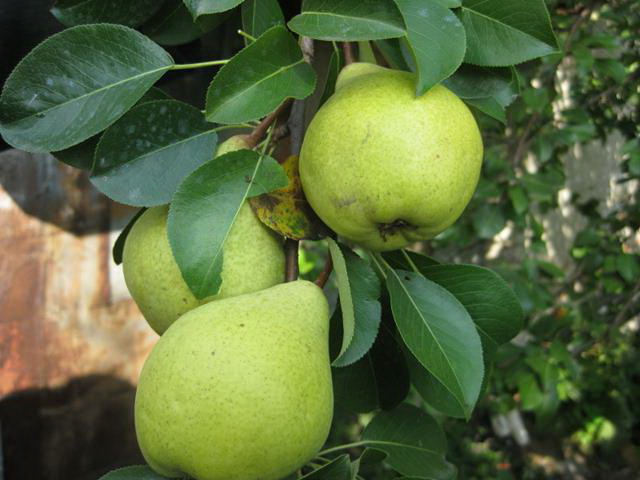
Pear Favorite, due to its high frost resistance, can winter without shelter, even in "risky farming zones"
The tree reaches a height of 3–3.5 m. The growth rate does not differ. The crown is not particularly thickened, the shoots are drooping. The harvest ripens at the end of summer. The shelf life of pears is up to one and a half months.
Fruits are blunt-conical, rather large (180–250 g). The pulp is white, very juicy. The pears are sweet, the taste is estimated at 4.5 points. Productivity - 35-40 kg from an adult tree. The variety is self-fertile; Krasulia, Severyanka, and other varieties blooming at the same time are suitable as pollinators.
Autumn
These pears usually ripen in late September or early October. Fruiting in some varieties is extended, lasts for a month. They are grown, as a rule, in central Russia, in order to precisely manage to harvest the crop before the first frost.
Simply Maria
A relatively new variety, bred in Belarus. In the Russian Federation, it is recommended for cultivation in the Central region. Frost resistance up to -38 ° С. The variety is characterized by early maturity, regularity of fruiting and high resistance to most diseases typical for the culture (scab, septoria, bacterial cancer).
Pear Just Maria should not be confused with the almost eponymous Russian variety Maria, bred in Crimea. There is also a completely new variety from Italy - Santa Maria.
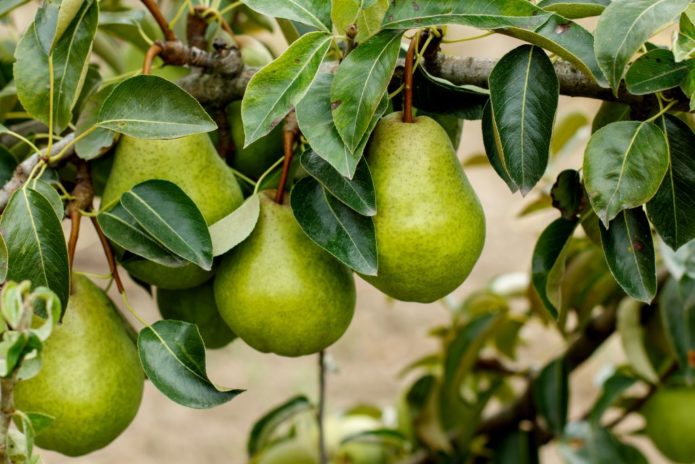
Pear Just Maria has nothing to do with the once very popular TV series, the variety was named after its creator, Maria Myalik.
The height of the tree reaches 3 m. The crown is conical, of medium density, compact (up to 2.5 m in diameter). The pear is shade-tolerant, but not shade-loving. The fruits ripen in late October or early November and are stored until the New Year. Average yield is about 40 kg.
Fruits are regular in shape, weigh about 180 g, individual specimens - 200-230 g. The skin is smooth, shiny, pale yellow, with a pinkish blush. The pulp is not particularly dense, butter-colored, buttery, very tender and juicy, with almost no aroma.The taste is balanced, sweet, with a slight sourness. It is rated very highly by tasters - 4.8 points. The percentage of non-marketable fruits is low - up to 10%.
Video: Belarusian pear Prosto Maria
Veles
Also known as the Excellent Daughter. The state register advises cultivating the variety in the Central Region. The first harvest pear brings in 5-7 years, then bears fruit annually. It tolerates the vagaries of the weather well, and is undemanding to care for.
The tree is tall (4–5 m), the crown is pyramidal. The shoots are thin, drooping. Flowers and buds tolerate short-term temperature drop to -2 ° C without damage. Overall frost resistance is also good - up to -30–35 ° С.
Fruits are regular, symmetrical. The skin is light green, with a bright orange-red blush. Average weight - 120 g, with a plentiful harvest, pears are slightly smaller. The pulp is beige-creamy, semi-oily, very tender and juicy. The taste is estimated at 4.6 points. The harvest, depending on the weather in summer, ripens at the very end of August and in the second decade of September. You can count on 60–90 kg of fruit. Pears are transportable.
Bere Moskovskaya
It is cultivated mainly in the Central region. Early autumn variety, ripens in early September. It is valued for its early maturity, frost resistance up to -30 ° C, high resistance to scab, rot, brown spot.
The tree is up to 3–3.5 m high. The growth rate does not differ. The crown is almost spherical, not too thickened.
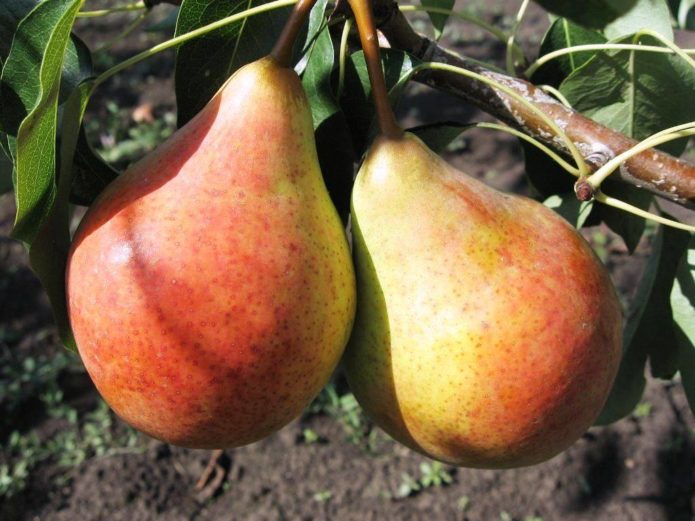
Pear Bere Moskovskaya does not tolerate drought well - moisture deficit negatively affects the taste of the fruit
Fruits are blunt-conical, weigh about 120 g. The skin is yellow-green, with a blurred raspberry blush. The pulp is snow-white, homogeneous, very tender and juicy. Sweet and sour taste is rated at 4.2 points. But with a lack of moisture in the heat, it deteriorates badly - the fruits become tart and sour. It is better to remove pears before full maturity, otherwise they begin to rot right on the tree. In the refrigerator, such fruits are stored for 2-3 weeks.
Marble
Recommended for cultivation in the Central region and the Volga region. The variety is characterized by the presence of a high resistance to scab, powdery mildew, fruit rot. It is valued for its high yield (up to 200 kg from an adult pear). Frost resistance is low (up to -10-15 ° С), the pear does not tolerate the vagaries of the weather. In drought, the fruits are massively crumbled. And a tree that has fallen under return spring frosts can not only lose flowers, but also die.
The height of the tree is up to 4 m. The crown is not particularly thickened, wide-pyramidal. Fruiting begins at the end of August and lasts until the second decade of September. The first harvest will have to wait 6-7 years. The shelf life of the fruit is two months or a little more.
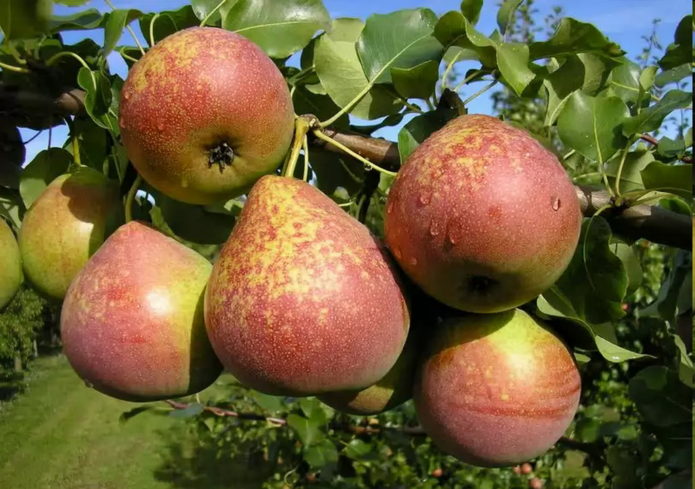
Pear Marble is not distinguished by its early maturity, but the excellent taste of the fruit is worth the wait
Pears reach a mass of 120-160 g, some specimens - 220 g. The shape is correct, round-conical. The skin is greenish-golden, rusty, firm but not rough. The blush is brick-colored or reddish-brown, in the form of separate strokes. The pulp is creamy white, coarse-grained, very tender and juicy, melting, with a pronounced aroma. The taste is sweet, but not bland, and is rated at 4.8 points. A variety from the dessert category.
Talgar beauty
The variety was bred in Kazakhstan, in Russia it is cultivated mainly in the North Caucasus. Frost resistance up to -30 ° С. The first harvest has to wait 4–5 years. The variety is unpretentious, transportable, and tolerates drought well.
The height of the tree reaches 3 m. The crown is wide-pyramidal, thickened. The harvest ripens in late September or early October. The shelf life of slightly unripe fruits is two months.
Pears weigh about 160 g, individual specimens - 250 g each. The skin is smooth, dense, pale golden in color, with a reddish-pink blush.The pulp is fine-grained, crispy, even rough. The taste is not bad, it even improves during storage. The best pollinators are Conference, Hoverla.
Video: pear variety Talgar beauty
Winter (late)
Winter pears are removed until the fruit is fully ripe. Their taste at this time is practically absent, the flesh is tough. But after they lie for several months in the refrigerator or cellar, the quality of the fruit improves significantly.
Lyre
Early winter variety, best suited for the Central Region. Cultivation of pears throughout Russia is hampered by low (down to -20 ° C) frost resistance. The crop is removed annually, without seasons of "rest". Fruiting is extended, lasts from the first decade of October to the beginning of December. The pear does not suffer from scab.
The tree is powerful, 5–6 m high. The crown is pyramidal, spreading, not too thick. The first fruits are tried already in the second year after planting. The shelf life of fruits at room temperature is 2-3 weeks, in optimal conditions - 3-3.5 months.
Pears are one-dimensional, weighing on average 140 g, some specimens - 200 g or more. The shape ranges from typically pear-shaped to elongated and blunt-conical. The skin is yellow-green, matte, a small part of the fruit is covered with a pastel pink blush. The pulp is white or yellowish, fine-grained, very juicy. The taste is sweet with a noticeable refreshing sourness. The aroma is almost absent.
Video: Lira pears
November
Also known under the names "Moldova" and "Winter". Created specifically for growing in the Far East. It is appreciated for its high annual yield and the presence of an "innate" immunity to scab. Extremely high frost resistance is characteristic - up to -50ºС.
The tree is tall (4–5 m), the crown is wide, oval. Shoots are actively branching. It almost never suffers from bacterial and sunburn. The first crop ripens three years after planting. You can count on 40-60 kg. Fruit can be stored without problems until early February. Top pollinators - Williams, Clapp's Favorite, Conference.
Fruits are small (60–65 g), with pronounced ribs, irregularly ovoid in shape. The skin is greenish, the blush (if any) is dull red or pinkish. During storage, the fruit turns yellow. It takes at least a month to ripen. The pulp is white, moderately oily, juicy, sweet and sour. The taste is very good. A pronounced aroma is characteristic. Ripe pears are firmly attached to the branches, do not crumble.
When grown in warm southern regions, the weight of the Noyabrskaya pear variety sharply increases to 300–350 g.
Video: the fruits of the November pear
Curé
An old French variety, a spontaneous natural mutation. It is often found under the names "Plebanovka", "Pastorskaya" and "Williams Winter". In Russia, it is cultivated mainly in the Black Sea region and in the North Caucasus. It tolerates drought, heat well, resists scab well. Frost resistance at the level of -25 ° C.
The tree is vigorous, reaches a height of 4 m. The crown is wide-pyramidal, spreading. Branches under the weight of the fruit slightly nod. The first crop ripens 4–5 years after planting. The pear bears fruit abundantly (80-100 kg), but with interruptions, the frequency of which is not visible. Harvest in early October, pears take at least 20 days to ripen. If you do not have time with this, the fruit quickly deteriorates.
Fruits of different sizes, uneven, weigh 160–250 g. Slightly elongated shape. The skin is thick, matte, greenish-yellow, rusty. Blush stains pears quite rarely. The pulp is yellowish-creamy, juicy, not too dense, with numerous "stony" blotches. This influenced the taste assessment - only 3.5 points. By the way, it varies greatly depending on the growing region.Also, gardeners note that the more abundant the harvest, the smaller the pears themselves. The best pollinators are Deccan, Clapp's Favorite, Saint-Germain.
Video: characteristic of pear Curé
Olivier de Serre
French variety cultivated for over a century and a half. In the Russian Federation it is zoned for cultivation in the North Caucasus. It is considered one of the best late winter pears. The first harvest will have to wait 6-7 years. The variety is transportable, partially self-fertile. Good pollinators - Favorite Clapp, Decanka, Williams. Thermophilicity and exactingness to the quality of the soil are noted as disadvantages.
The tree is medium-sized, reaches a height of 4–4.5 m. In young specimens, the crown is pyramidal, with age it seems to "squat". The harvest begins in the first decade of October, it is ready for use in December. Pears are stored until early spring.
The fruits are of different sizes, the average weight is about 150 g. In shape, they are slightly flattened, tuberous at the base. The skin is grayish-green (in the process of maturation it changes color to dark yellow), rough, very dense. Strong rustiness is characteristic. The pulp is firm, homogeneous, melting, very juicy and aromatic, with a slight almond flavor. The taste is highly rated - 4.5 points.
Emerald
One of the novelties of selection. Late winter variety, recommended by the State Register of the Russian Federation for cultivation in the North Caucasus. The pear is undemanding to the quality of the substrate, but reacts poorly to a lack of light and heat. The variety is valued for its early maturity, annual fruiting, immunity to scab and fire blight, and transportability.
The tree reaches a height of 3.5–4 m. The crown is in the form of an almost regular ball, not particularly thickened. The crop is harvested at the end of October, it ripens within 10-15 days. The variety is partially self-fertile, good pollinators - Vassa, Dekanka, Maria, Bere Bosk.
The pears are very large (240 g or more), barrel-shaped. The greenish-yellow skin is almost invisible under a thick layer of crimson-raspberry blush. The pulp is creamy, fine-grained, dense, but very tender and juicy. The taste is sweet and spicy, the aroma is almost absent. A variety from the dessert category. The taste is rated at 4.8 points.
For the Moscow region
The climate in the Moscow region is rather mild. Severe winters with little snow are generally not typical for the region. Summers are usually quite warm. Therefore, pears of any ripening period can be planted here. Most often, gardeners prefer summer and autumn varieties.
Elegant Efimova
A variety from the early autumn or late summer category. Recommended for cultivation in the Volga and Central regions. Frost resistance up to -20ºС. It is extremely rarely affected by scab. Doesn't pay much attention to the vagaries of the weather, puts up with the lack of light and heat. But it needs annual pruning. The best pollinators are Yakovlev's Favorite, Moskvichka, Marble, Bessemyanka.
The tree is 4–5 m high, fast growing. Crown in the form of a pyramid, medium thickening. The first harvest will have to wait at least 7–8 years. Then you can count on 40 kg per tree. It is advisable to pick the fruits unripe. They ripen within 15–20 days. On a tree, fruits quickly deteriorate - the pulp becomes viscous, watery, and loses its taste.
Pears are one-dimensional, symmetrical, weighing 110–135 g (individual specimens up to 185 g), elongated. The skin is smooth, golden-green. It is almost completely covered by a rose-red blush. The pulp is creamy white (pinkish at the skin), sweet and sour, slightly tart, very tender and juicy. The taste is balanced, estimated at 4.5 points.
Lada
Recommended for growing not only in the European part of Russia, but also in Eastern Siberia. The variety is early summer, with a very good (up to -30 ° C) winter hardiness. It is appreciated for its early maturity, consistently high yield, immunity to scab and fire blight. As a disadvantage, there is a low transportability and keeping quality (no more than 6-8 weeks).
The tree reaches a height of 2.5–3 m. The crown is conical, dense. The crop ripens in early August. The fruit will have to wait three years. Productivity - about 50 kg. The variety is self-fertile, but it is still recommended to have Severyanka, Rogneda, Chizhovskaya nearby.
Pears weighing 100-120 g, as if flattened, with pronounced ribs. The skin is thin, glossy, pale yellow, subcutaneous points are almost invisible. Blush blurred, light red. The pulp is butter-colored, fine-grained, very aromatic, not particularly juicy. The taste is refreshing, sweet and sour.
Video: characteristics of the pear Lada
August dew
The variety is recommended for cultivation in the Black Sea region, but it also shows itself very well in the Moscow region. Frost resistance down to -36ºС allows cultivating it in more severe conditions. The pear has an "innate" immunity to scab and septoria, it tolerates drought well.
The height of the tree is no more than 3 m. The crown is thickened, the shoots are drooping. Fruiting annually starting from the 4th year after planting. Productivity - 50–70 kg. Fruits ripen in the second half of August or early September. They are stored for a short time - 12-15 days, in the refrigerator - up to three months.
Pears weighing about 130 g (individual specimens up to 200 g), blunt-conical. With a plentiful harvest, uneven fruits are noted. The skin is dull green, there is no blush. The pulp is pale yellow, fine-grained, very juicy. The taste is sweet and sour, estimated at 4.5 points. The best pollinator is the Yakovlev memory pear.
Video: pear variety Augustow dew
Gardeners reviews
We planted Chizhovskaya pear in our country house in 1998 as an annual sapling. The tree grew without any problems. Although the site is on a hill and is heavily blown by the winds, it never froze. Every year we were looking forward to at least one fruit to taste it. A couple of times there were several fruits, but we did not get them. While we came again, birds already managed to peck them, and they fell. But our patience has been rewarded! We got a wonderful harvest last year! Our beauty looked so luxurious with fruits that we were sorry to deprive her of such an outfit! The husband was as happy as a child. The taste of this variety is amazing. The pulp is juicy, sweet. And what a scent !!! You can safely grow this variety.
The fruits of the pear in Memory of Yakovlev contain the maximum amount of substances most valuable to humans - arbutin and chlorogenic acid in one variety (which is rare among pears). Another pluses of Yakovlev's Memory are its short stature, fibrous roots (can be planted at a high level of groundwater), horizontal arrangement of skeletal branches, self-fertility, immunity from scab, early onset of fruiting, and much more useful. This is the best pear for me.
My Williams has been growing since 2004, the only summer variety that I left on the site. Very juicy, beautiful (if on the market), every year without a pass bears fruit abundantly, does not get sick.
I have three pears growing. Severyanka is the oldest resident of the site, Chizhovskaya is a seven-year-old tree, and Brusnichnaya (three years). Severyanka is a very unpretentious, excellent pollinator for all other varieties. The harvest is huge, we roll up juices without adding sugar. In the early years, they simply gorged themselves on pears. Sweet, simple, juicy, granulated. Now no one eats, they are stuck.
Pear Just Maria is something !!! We have our first harvest, we are in shock !!! We have always only dreamed of pears and thought that it was not with our climate ... Three years ago, in the spring, they planted Just Maria, Kudesnitsa, Belorusskaya Late and Veles. This year was the first harvest. Just Maria performed the best.There were about thirty pears, ten of which we plucked ahead of time, because we didn't have the patience to wait. A couple of days ago they removed the rest. Now here they are in the basement, a couple of pieces a day ripening. They taste like delicious pears can be.
Some experts believe that for the pears of our strip Veles is the standard of taste. The pear is good, otherwise I would not have planted it. Why criticize her ?! But Moskvichka is the only variety that is genetically resistant to fire blight, the infection on Veles that I fought this year. Then I read somewhere that because of these qualities, Muscovites will certainly breed new varieties with her participation.
In the fall, I will remove the Marble tree. I didn't like too much about her. First, the sweet taste. Yes, there is a lot of sugar in it, but without harmonious sourness, I do not accept the taste of a pear. Secondly, in my experience, the tenderness and aroma of its fruits are greatly exaggerated. In addition, the tree is constantly sick, and it is not clear why. Either there is some kind of chlorosis on the leaves, then suddenly there is no young growth, then the fruits stop growing for no reason, they grow stiff and hang like this until late autumn, and remained inedible. Moreover, other varieties nearby grow well, develop and bear fruit.
Pear Talgar beauty is problem-free, very fruitful. During her life (and she is more than 30 years old), there was no harvest for only one year. I don't remember the reason anymore, but that year there was no fruit on all the trees. At the end of August it is already in time. The market is for sale. Huge, beautiful ones grow on the tops of the pear. No sores were noticed. Only at the beginning of the season does aphid appear on young tops. But this is quickly corrected by spraying. I would not say that she has good keeping quality. If you collect ripe, then during storage it turns into a "potato". But on the tree it remains well. It can hang until the very frost. Usually I collect and bring home, so that it will last for a week, then another. It no longer responds to feeding. Apparently, at that age she no longer needs them. Although once a season, when the fruits are set, I fertilize and water. At my neighbors, Talgar Beauty was planted with me at the same time, it grows without care - no one watering it, fertilizing it, and the volume of the harvest and the size of pears do not differ from mine.
My opinion: the November pear is fruitful, beautiful, very large fruits, but the taste is somehow not very good. The pulp is not tender and does not melt, although it was kept on the tree until frost.
The Curé pear is perfectly preserved, even in a relatively insulated garage. Sometimes you have to look through the fruits during storage and select spoiled ones, but, as a rule, there are very few of them. By this time, Curé's taste is simply amazing!
From the point of view of industrial horticulture, in my opinion, Olivier de Serre is not the best variety for Kharkov, since it is heat demanding, but from the point of view of sports interest, I think it is worth trying, at least, grafting, since Simirenko himself describes this variety as one of the best.
The Lada pear tastes good, but if you overexpose it on a tree for several days, it tastes like potatoes.
August dew is one of the most beloved pears in our family. Small, neat tree. Trouble-free in terms of winter hardiness, drought resistance, disease and pest resistance. Standard care is enough for him. Lined pears - 130–150 g. A very harmonious combination of acidity and sweetness (not bland-sweet, which I don't like in pears). Very juicy, with tender, melting pulp. Especially good if removed on time and put in the basement for at least a week. Then the aroma appears more strongly, the spice appears in the taste. Ripens in our conditions in the second half of August. A wonderful variety with one, but serious drawback - there is always little of it. I would eat and eat, but it ends quickly! I want to plant one more tree.
It is easy to get lost among the wide assortment of pear varieties presented in specialized stores and nurseries. They differ in terms of ripening, dimensions of trees, taste and other qualities of the fruit. Almost everyone has undeniable merits. With them, as well as with the shortcomings, you need to familiarize yourself in advance in order to determine the main criteria and choose the variety that best suits you.
